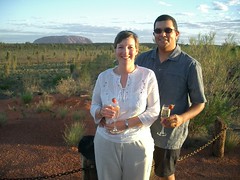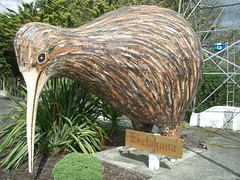Wednesday, May 31, 2006
Food In Japan
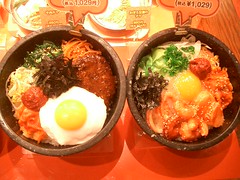 We didn't really worry that we'd go hungry in Japan but it's probably fair to say that we were a little concerned about how we'd actually order a meal, and whether we would recognise what it was when it arrived. As it turned out there are numerous reasons why finding food here is very easy.....
We didn't really worry that we'd go hungry in Japan but it's probably fair to say that we were a little concerned about how we'd actually order a meal, and whether we would recognise what it was when it arrived. As it turned out there are numerous reasons why finding food here is very easy.....Plastic Food!
Lots of restaurants (and not just the cheap ones) have extensive displays of plastic food in the windows. This doesn't appear to be done solely to help foreigners, but it's pretty helpful. It does get a bit tricky when there are no matching pictures on the menus indoors, but then you can always point at the plastic food or (as we tried once or twice) you take the menu out into the street and compare the Japanese writing in the window with the menu and try and figure out which one you want!
Vending Machines
Some other restaurants, usually fast food type places, have vending machines instead of plastic food. The machines don't actually dispense the food, just a ticket that you take to the counter and exchange for some real food. Out on the street and there are vending machines everywhere. Even in the fairly residential area where we stayed in Tokyo there were machines on almost every corner or in doorways. The machines mainly sold drinks (including beer) but cigarettes and ice cream were quite common, and on station platforms you could even get hot food (ie. frozen ready-meal hot dogs and the like).
Convenience Stores
Self Catering in Japan proved to be a little difficult, we only stayed in one place that actually had a kitchen and we only rarely stumbled across anything that could be described as a supermarket. However, it seems that buying your evening meal from the local shop is fairly common. It doesn't sound all that appealing I know, but there was a huge range and some of them were quite good, and since it feels like you're never more than 50 paces away from a '7-11' (or similar) store you will always be able to find hot, microwaved noodles (Mmmm...).
Familiar Food..... or is it?
There are many familiar food labels in the shops, sometimes these are the same products but occasionally they have a bit of a Japanese twist to them, most notably the bright green Kit Kat which we guess was meant to be green tea flavoured.
Tuesday, May 30, 2006
How To Hide A Volcano
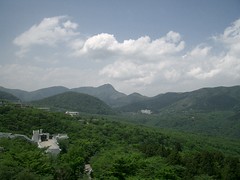 Since the weather wasn't great when we arrived in Japan we decided to leave Mount Fuji until the end in the hope that things would improve. So having made our way back to Tokyo we had a couple of days to choose from in which to do it as a day trip. Things were looking quite promising as we headed west again on the train, and we started to get really confident when we arrived at Hakone and found fairly clear blue sky. Unfortunately we had underestimated the ability of the mountain to attract large amounts of cloud. So we had a day of almost perfect weather but we saw abolutely nothing of Mount Fuji.
Since the weather wasn't great when we arrived in Japan we decided to leave Mount Fuji until the end in the hope that things would improve. So having made our way back to Tokyo we had a couple of days to choose from in which to do it as a day trip. Things were looking quite promising as we headed west again on the train, and we started to get really confident when we arrived at Hakone and found fairly clear blue sky. Unfortunately we had underestimated the ability of the mountain to attract large amounts of cloud. So we had a day of almost perfect weather but we saw abolutely nothing of Mount Fuji. It's an extremely easy day trip from Tokyo and it looks like it's made by millions of people each year, so there were occasions where we were just following the crowd. The route involves taking a train, a couple of cable cars (from which you might see the mountain), and then a boat trip across a lake on a very cheesy looking fake pirate ship (Why?!). So no arty photos of Mount Fuji, but some great ones of the pirate ships!!
Saturday, May 27, 2006
Nara
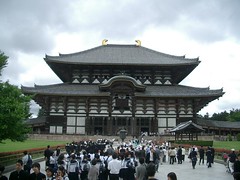 The major attraction at Nara is the Todai-ji Temple, the largest wooden structure in the world and built to house an exceedingly large Buddha. The temple has of course been rebuilt over the years and must have been even more impressive in it's early days, because despite it's current world record size it is only two thirds of it's original size. We were starting to be affected by 'Temple Fatigue' at this point, but we continued on around the sights of Nara park (managing to avoid being harassed by the wild deer) and eventually stumbled on yet another wedding. I think much of the main ceremony had already taken place inside one of the temples, but we got to see the end of the proceedings which continued outdoors. The wedding party all seemed remain remarkably composed considering that there were 50 or so tourists just behind them taking pictures!
The major attraction at Nara is the Todai-ji Temple, the largest wooden structure in the world and built to house an exceedingly large Buddha. The temple has of course been rebuilt over the years and must have been even more impressive in it's early days, because despite it's current world record size it is only two thirds of it's original size. We were starting to be affected by 'Temple Fatigue' at this point, but we continued on around the sights of Nara park (managing to avoid being harassed by the wild deer) and eventually stumbled on yet another wedding. I think much of the main ceremony had already taken place inside one of the temples, but we got to see the end of the proceedings which continued outdoors. The wedding party all seemed remain remarkably composed considering that there were 50 or so tourists just behind them taking pictures! Friday, May 26, 2006
Kanazawa
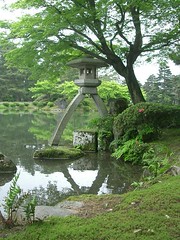 Today's day trip from Kyoto took us up to Kanazawa on the north coast on the excitingly named 'Thunderbird' express train. Highlight of the day here was the Myoryuji Temple, more commonly known (in the guide books anyway) as Ninja-Dera. Anything with the word 'Ninja' in the title is bound to make for a steady flow of tourists. We were lucky to turn up in time for a tour, these are only conducted in Japanese but they have a really handy homemade booklet for the English speakers to follow along with. There's no mention of actual Ninjas in the tour, but the temple was the home of an important lord who had numerous Samurai around to defend him against all the other lords who wanted to stick sharp swords into him (obviously we're summarising the story a bit here). It might not have had Ninjas but it did have many great features to help the main man stay alive. So it really does have secret doors, hidden floor compartments, trapdoors, and of course a small hidden room where if all else had failed the lord would be able to honourably commit suicide.
Today's day trip from Kyoto took us up to Kanazawa on the north coast on the excitingly named 'Thunderbird' express train. Highlight of the day here was the Myoryuji Temple, more commonly known (in the guide books anyway) as Ninja-Dera. Anything with the word 'Ninja' in the title is bound to make for a steady flow of tourists. We were lucky to turn up in time for a tour, these are only conducted in Japanese but they have a really handy homemade booklet for the English speakers to follow along with. There's no mention of actual Ninjas in the tour, but the temple was the home of an important lord who had numerous Samurai around to defend him against all the other lords who wanted to stick sharp swords into him (obviously we're summarising the story a bit here). It might not have had Ninjas but it did have many great features to help the main man stay alive. So it really does have secret doors, hidden floor compartments, trapdoors, and of course a small hidden room where if all else had failed the lord would be able to honourably commit suicide. Unfortunately, as is the case with almost all the temples and shrines that we've visited here, you can't actually take any photographs inside So you will just have to take our word for it that we aren't making it all up after one Sake too many.......
More Kanazawa photos here, here and here.
Thursday, May 25, 2006
Back To School
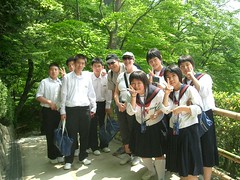 Kyoto was also our first proper encounter with Japanese school children. Hordes of them. We had noticed in Tokyo that there didn't seem to be a single day of the week when they weren't either at school or on some kind of field trip. Then we started to see increasing numbers of them on our Shinkansen journeys, and then when we arrived in Kyoto we established that it seemed to be school trip season. Not just individual class trips, but seemingly an entire school year would head down to the station together and then speed off to visit the great historical and cultural sights, which of course was exactly where we were headed.....
Kyoto was also our first proper encounter with Japanese school children. Hordes of them. We had noticed in Tokyo that there didn't seem to be a single day of the week when they weren't either at school or on some kind of field trip. Then we started to see increasing numbers of them on our Shinkansen journeys, and then when we arrived in Kyoto we established that it seemed to be school trip season. Not just individual class trips, but seemingly an entire school year would head down to the station together and then speed off to visit the great historical and cultural sights, which of course was exactly where we were headed.....We also soon discovered that they have another little 'side task' when they are out on the road, they have to randomly approach likely looking tourists and engage them in conversation in order to practice their English.
We'd barely stepped off the train in Kyoto, and we stood still for a just little too long reading the English sign in the tourist info. office before we were pounced upon by the first group. Fortunately you don't get mobbed by the whole school, they seem to split into groups of 4-6 kids, usually evenly split between boys and girls. It turns out that this is great fun and we got to quite enjoy it, not least because it's amazing how enthusiastic and grateful they are when you agree to help them, although after about the third group in a single afternoon it does get a little bit tiring to repeat many of the same answers.
Most of the groups we spoke to were around 13 or 14 years old, although some were as young as 11. They all have a set of fairly basic questions to ask you (what's your name, where are you from, etc.). The questions are written down phrasebook style although in many cases the older ones had embarrassingly good understanding when compared to our comical attempts at a few basic Japanese words! Then you'll sometimes get asked to write a message in their notebooks, which we assumed that they then took back to class and attempted to decipher. Our Hiroshima experiences served us well when answering the question "What is your favourite Japanese food?" and we got a few enthusiastic nods when we answered "Okonomiyaki", although this may well have been because we were the first people ever who hadn't said "Sushi".....
Their final request, for which they seem to get some kind of bonus marks back at school, is to have their photo taken with you. You will notice from the photos that, from a young age, it seems it is virtually impossible for the Japanese to have a camera pointed at them without them all instinctively breaking into two-fingered 'peace' signs. Very odd!
Wednesday, May 24, 2006
Kyoto
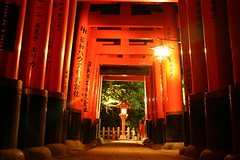
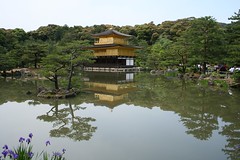
A few years ago we visited Milan and found that there seemed to be a church on every corner, if the local tourist board here in Japan's old capital don't have a catchy line for their advertising they could always use "Kyoto... It's like Milan... but with Buddha", there are quite literally hundreds of temples here. The temples are also quite spread out, around a city that seems to get larger every time you try to walk anywhere, so we quite quickly took to the buses! It was well worth all the trekking about though as there are some quite fantastic buildings here, many of which probably appear on the front of guidebooks and holiday brochures, and it seems as if half the town has World Heritage status for one reason or another. I'm sure you won't want to hear about them all one by one, but there are of course many photos to tell the story (Golden Pavillion, Kiyomizu-Dera, Fushimi-Inari, Ryoan-Ji, Nijo Castle, Koryu-Ji).
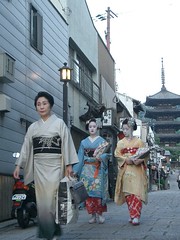
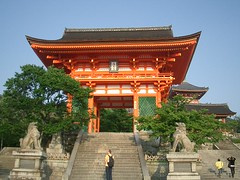 Kyoto will also be remembered for (so far) the strangest place we have stayed on our trip. We had been in hotels for over a week so we were looking forward to getting back to a hostel environment, however even though we'd booked a week in advance all the places we'd seen recommended were full. This left us with a hostel that we'd seen advertised on the notice board of the place we stayed in Tokyo. It looked OK(ish) and they had a nice little map to help you find the place. It still took us a while to track it down and it was dark by the time we arrived, it looked like quite a nice place although there was a notable absence of anyone resembling a member of staff. After a few minutes of waiting we figured out the little poster which explained that we should pick up the telephone and hit a speed dial button to summon assistance. Nobody answered the phone but after a few minutes someone turned up, he didn't speak any English but we eventually figured out that he was telling us that we were in the wrong building. Oops. Conveniently though it seemed to be owned by the same people and we just needed to be on the other side of the (very) narrow lane.
Kyoto will also be remembered for (so far) the strangest place we have stayed on our trip. We had been in hotels for over a week so we were looking forward to getting back to a hostel environment, however even though we'd booked a week in advance all the places we'd seen recommended were full. This left us with a hostel that we'd seen advertised on the notice board of the place we stayed in Tokyo. It looked OK(ish) and they had a nice little map to help you find the place. It still took us a while to track it down and it was dark by the time we arrived, it looked like quite a nice place although there was a notable absence of anyone resembling a member of staff. After a few minutes of waiting we figured out the little poster which explained that we should pick up the telephone and hit a speed dial button to summon assistance. Nobody answered the phone but after a few minutes someone turned up, he didn't speak any English but we eventually figured out that he was telling us that we were in the wrong building. Oops. Conveniently though it seemed to be owned by the same people and we just needed to be on the other side of the (very) narrow lane. So, relieved that we'd eventually found the place, we wandered across the road...... and into a building that didn't actually appear to have been finished yet. Lovely. There was however a black and white printed piece of A4 taped to the wall announcing that we had indeed found the fine establishment for which we had been searching. Fortunately the lady at 'reception' (a small side room with a steel door) knew who we were and was expecting us, so things were going well. Things got even better when she showed us the common room, which had free internet access (look, you get to be grateful for these little things after a while!).
Then she started to show us around and it started to get a bit scary again....... The kitchen, oh the kitchen. About the only thing that looked safe to use was the microwave, although it might be better to leave the room when it was actually on unless you needed an X-Ray. The toilet, that's THE toilet, the one and only toilet for the whole building. Also, it was a Japanese toilet, not a 'Western' toilet, I won't go into details except to say that these things are tricky to use unless you've been trained in the art of crouching from a young age..... It was also technically the GENTS toilet, the ladies were given the use of a Western toilet but that was, um, in the other building.... back across the street! The single shower room was also designated as the mens shower, the ladies had a much nicer shower, but that was..... er..... yup, you've guessed it, back across the road again, and it was only open between 9am and midnight!!
But after all that it really wasn't such a bad place (honestly!). The room was quite large, the sleeping mats reasonably comfortable, and there was a fridge outside our room where we could store drinks. There was no laundry as such, but there was a household washing machine which was free to use. We had the company of some interesting guests (inmates?), a solo American traveller, a Scottish bloke (whose wife never appeared), a Japanese man who seemed to be a book salesman, and a monk. The monk was quite a character, quite an achievement considering that he never really spoke a word to anyone, but every night he would cook himself an identical and impressive looking meal (he was the only one actually using the kitchen) and proceed to sit in the middle of the room, apparently oblivious to everyone else, and eat..... whilst listening to his iPod (this is the 21st century after all).
Sunday, May 21, 2006
Back Up The Line
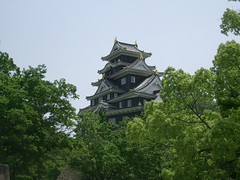 After a couple of days in Hiroshima we started to make our way back east in the direction of Tokyo. We had a few stops to make before reaching our next main stop in Kyoto, but some of these only involved a few hours in one town before moving on to the next. These short stops were really easy as every station in Japan has storage lockers which cost a couple of pounds a day, so as long as you're traveling light (which we were for once) you can just jump off the train and dump your luggage for a few hours while you check out the town.
After a couple of days in Hiroshima we started to make our way back east in the direction of Tokyo. We had a few stops to make before reaching our next main stop in Kyoto, but some of these only involved a few hours in one town before moving on to the next. These short stops were really easy as every station in Japan has storage lockers which cost a couple of pounds a day, so as long as you're traveling light (which we were for once) you can just jump off the train and dump your luggage for a few hours while you check out the town.Okayama & Kurashiki
We didn't find a great deal at Okayama, although it has a castle (of course!) and one of the three finest gardens in Japan (which was closed by the time we got to it!). A few minutes away by train is the smaller town of Kurashiki, which has a very attractive old town area. We stumbled across what looked like a rehearsal for a festival so for an hour or so we followed the two small groups as they paraded around the town before meeting up by the river.
Himeji
After another short train journey we stopped for a couple of hours at Himeji. It's another very impressive looking castle, but again it's had a great deal of renovation. In some cases it's difficult to tell how much of the work has been renovation and how much has been outright rebuilding, but whichever it is these places do all look very impressive.
Kobe
This wasn't part of our original plan but we decided to make it an overnight stop to give us a few hours to look around. We briefly considered whether we should try the famous local beef whilst we were in town, but in the end we opted to save the money and instead headed off for an exciting 'dining experience' in the local night market. Half the fun was in identifying what you were actually eating, although in many cases we were only able to narrow it down to 'Land Mammal' or 'Marine Life'!
Before leaving the next morning we visited the earthquake memorial and then decided to do the full circuit on the local 'tourist' bus as the weather had turned somewhat 'monsoonal'. This turned out to be one of the least effective tourist buses ever, as the announcements were only understood by Japanese speaking tourists, all the seats faced inwards, the windows had steamed up, and everyone else in town had had the same bright idea as us so it was a bit overloaded!
Saturday, May 20, 2006
Hiroshima
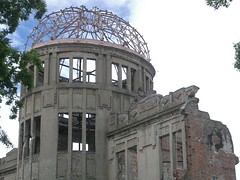 There are two sides to Hiroshima. At first glance it's a fairly normal looking place, without much that really distinguishes it from many other Japanese towns, although this being Japan it does have a number of impressively large designer clothing stores. The designer stores are of course not the main reason why people visit the city. One of the only surviving pieces of pre-war architecture is the building now known as the A-Bomb Dome which stands at the edge of the Peace Memorial Park. It is surprisingly intact, having only survived because it was almost directly below the bomb, and was therefore not hit side on and flattened by the blast. The building has been left exactly as it stood 60 years ago and is now surrounded by a number of memorials and shrines.
There are two sides to Hiroshima. At first glance it's a fairly normal looking place, without much that really distinguishes it from many other Japanese towns, although this being Japan it does have a number of impressively large designer clothing stores. The designer stores are of course not the main reason why people visit the city. One of the only surviving pieces of pre-war architecture is the building now known as the A-Bomb Dome which stands at the edge of the Peace Memorial Park. It is surprisingly intact, having only survived because it was almost directly below the bomb, and was therefore not hit side on and flattened by the blast. The building has been left exactly as it stood 60 years ago and is now surrounded by a number of memorials and shrines.The park itself has numerous memorials and shrines dedicated to the Japanese, and people of other nationalities, who died. There is also a display of paper cranes, these are here in memory of a young girl who died of leukemia 10 years after the atomic bomb. She had believed that folding paper cranes would help her recover. The Childrens Peace Monument was built in her memory and millions of cranes are now sent from around the world each year. You can make one yourself if you wish. If you happen to be delivering a large number on behalf of a school you're asked to leave the details so that a record can be kept of the donations.
At one end of the park is the peace memorial museum, we didn't visit the main part of the museum because we spent quite some time at two temporary exhibitions. The first was a collection of paintings by survivors, these seem to have been painted relatively recently and so in many cases they are the childhood memories of people who are now pensioners. Most of these people are not expert painters, but it really didn't matter as each piece was accompanied by the artist's explanation of what they had actually seen. The second exhibition was the work of two young Japanese photographers who were sent to Hiroshima only a few days after the bombing. These photos were apparently suppressed for quite some time in an attempt to cover up the full extent of the destruction.
The other main tourist site in the town is Hiroshima Castle. This was the wartime headquarters of the Japanese army and therefore the reason for Hiroshima being targeted. As a result of this it was also the first of many castles we would visit that were actually much younger than they looked, the result of extensive renovation and rebuilding since the end of the war.
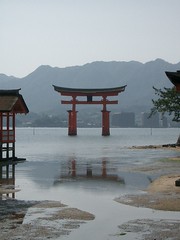 A short tram and ferry journey from Hiroshima is the temple complex at Miyajima, the most distinctive landmark here is the 'floating' Torii. It's not really floating, it just looks that way if you arrive at a suitably high tide (if not then it just looks like an archway sticking out of the mud!). We were very fortunate to be here on a Saturday when there was a wedding going on, so we can report that it takes just as long to arrange wedding photos in Japan as it does in England!!
A short tram and ferry journey from Hiroshima is the temple complex at Miyajima, the most distinctive landmark here is the 'floating' Torii. It's not really floating, it just looks that way if you arrive at a suitably high tide (if not then it just looks like an archway sticking out of the mud!). We were very fortunate to be here on a Saturday when there was a wedding going on, so we can report that it takes just as long to arrange wedding photos in Japan as it does in England!!Back in town and we were starting to get reasonably confident with the food, so we hunted down the food hall where all the restaurants serve nothing but the local speciality 'Okonomiyaki'. This apparently translates as something like "As you like it", which still doesn't give you much idea what it might be. It's basically an omelette filled with layers of noodles, beansprouts, onions, cabbage, some meat of your choice and a thick soy/BBQ kind of sauce, and it's actually very good, especially if you're worried that there is nothing but raw fish here.
Friday, May 19, 2006
Shinkansen.....
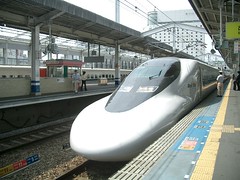 .... A.K.A. The Bullet Train. It is possible to fly between major cities in Japan but I don’t really know why you’d want to in most cases. For those of you in the UK just forget most things you know about trains unless you’ve been on Eurostar or TGV, in which case it’s similar but with much more legroom!). Before I go on I must point out that neither of us are ‘Train Spotters’, but travelling here leads to the kind of enthusiasm that might give that impression!!
.... A.K.A. The Bullet Train. It is possible to fly between major cities in Japan but I don’t really know why you’d want to in most cases. For those of you in the UK just forget most things you know about trains unless you’ve been on Eurostar or TGV, in which case it’s similar but with much more legroom!). Before I go on I must point out that neither of us are ‘Train Spotters’, but travelling here leads to the kind of enthusiasm that might give that impression!!Japanese stations would be considered ripe for ‘downsizing’ by Western management, everywhere you look there are immaculately dressed (right down to the white gloves!) staff to help you on your way. Most ticket gates are automated but you’ll still find 2 or 3 people on hand to help (This isn’t Hayes & Harlington, your chances of fare dodging here are next to nil; yes that means YOU Philip!).
Once on the platform it’s like you are watching a computer game or a model railway. On the line that runs west from Tokyo there are something like 12 Shinkansen services an hour, this means that at peak times you could be at a station 300km from Tokyo (as we were) and there would be three trains within 10 minutes that would all take you there. You need to be on time though, because the train definitely will be and it won’t muck around waiting for you. (If you’re interested the official statistics for 2003 show that the average Shinkansen delay on this line was 0.1 minutes, that's er, 6 seconds)
To help make sure this all goes smoothly the platforms all have markers on the floor telling you precisely where to stand and queue for, say, carriage 8. When it turns up the door will be directly in front of the start of the queue. The painted queue marker allows space for the disembarking passengers, and then you have about 60 seconds to file aboard before the doors close and the (white gloved) station attendant waves the train away. If you are at the front of the queue you’ll just about have time to put your bag on the rack and sit down before you feel movement.
Then after a while the ticket inspector will pass through the train (white gloves again). As he enters and leaves each carriage he bows. If you’re getting on at the first station on the line he also gives a little speech, which we assume goes something like “Good morning ladies and gentlemen my name is Bob and I’ll be your conductor today. Please do not hesitate to ask if I can be of any assistance. Thank You for choosing Japan Railways for your trip today”. On the other hand he might be saying “I will shortly be checking your tickets, if you do not have one please throw yourself from the train now to avoid embarrassment”. Either way, they’re very polite about it!
Then the refreshments trolley arrives (which occasionally has it’s own little musical theme tune). Again there is bowing at the carriage door (although the gloves may be plastic food handling versions this time). And then after a while longer of sitting in great comfort, your 90 minute journey has ended before you realise it (as indeed it has as I type this note!), at which point you once again need to be ready, as you’ll only have about 30 seconds to make it to the door before the next passengers start boarding.
Thursday, May 18, 2006
The Imperial Palace
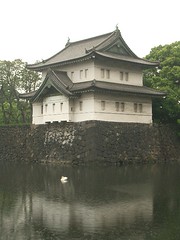 This is probably as close as you’ll get to finding the centre of the city. The palace and gardens cover quite a lot of ground in a city where land is very, very expensive. Apparently back in the peak property price years of the 80’s/90’s this piece of land was theoretically worth more than the state of California (according to the travel guide we watched on the plane).
This is probably as close as you’ll get to finding the centre of the city. The palace and gardens cover quite a lot of ground in a city where land is very, very expensive. Apparently back in the peak property price years of the 80’s/90’s this piece of land was theoretically worth more than the state of California (according to the travel guide we watched on the plane).All of this would be great if you could actually see it! The gardens are quite impressive, and you can get into some of the old castle areas and see some impressive walls and guard houses. You can also see from a distance the fairly dull looking ‘new’ palace. But the original palace? Well, we never managed to find a spot from which we could actually get a view of it, so I’m afraid we can only offer photos of the surrounding areas!
Wednesday, May 17, 2006
Tea For Two
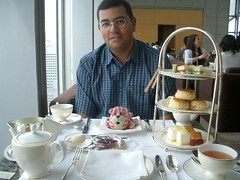 It all started when we were looking at the price of the observation decks around Tokyo. There are a few that are free or very cheap, but if you want visit the deck of the Mori Tower in Roppongi (which we’re told is good) it will cost you 1500 Yen (just over £7). So while were in Shinjuku we popped into the Park Hyatt hotel (come on movie fans, you know the one...), partly because I wanted to see what a hotel lobby on the 41st floor looked like, but also because we thought we might get a good view for free before they threw us out!
It all started when we were looking at the price of the observation decks around Tokyo. There are a few that are free or very cheap, but if you want visit the deck of the Mori Tower in Roppongi (which we’re told is good) it will cost you 1500 Yen (just over £7). So while were in Shinjuku we popped into the Park Hyatt hotel (come on movie fans, you know the one...), partly because I wanted to see what a hotel lobby on the 41st floor looked like, but also because we thought we might get a good view for free before they threw us out!Anyhow, once we were up there we discovered two things. Firstly, the actual hotel reception area isn’t really near any windows, but the lounge and bar area outside the elevators does have windows on three sides. This led us to our second discovery, and our Top Tip for Tokyo.
For 3000 Yen each (about £14.50) you can have afternoon tea between 2pm and 5. This might sound quite a lot, but it’s an expensive hotel, and when you compare it to the 1500 Yen just to stand and look out of the Mori Tower it’s not too bad. Particularly when you can literally sit there for three hours between 2 andl 5, taking in the view and enjoying apparently unlimited pots of tea and canapes to accompany your sandwiches and cakes. And they even offered us the opportunity to charge it to our room at the end........ which was very tempting considering we weren’t staying there!
We got some fairly good photos but the weather wasn’t really on our side. If you can manage to visit on a clear and sunny day then you will get a great view of Mount Fuji (not our photo of course!).
Tuesday, May 16, 2006
Tsukiji Fish Market
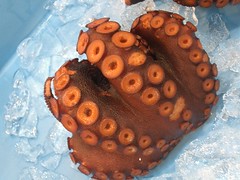 This is actually called the Central Wholesale Market, so there is a great deal of fruit and veg here as well, but the main tourist attraction is the fish market. If you get here at 5am you can watch the auction itself (Who thinks we got up that early?!). We made it for just after 8, so we missed the early excitement but we were still able to find the largest fish either of us have ever seen being wheeled around on large trolleys. Vegetarians and the squeamish may wish to change channels now.....
This is actually called the Central Wholesale Market, so there is a great deal of fruit and veg here as well, but the main tourist attraction is the fish market. If you get here at 5am you can watch the auction itself (Who thinks we got up that early?!). We made it for just after 8, so we missed the early excitement but we were still able to find the largest fish either of us have ever seen being wheeled around on large trolleys. Vegetarians and the squeamish may wish to change channels now.....You are quite free to wander around the market and watch these giant fish being ‘prepared’ for restaurants (ie. cut into smaller pieces using 6ft long knives). Nobody seems to mind spectators as long as you get out of the way when they need to get past. We met a Canadian who was being shown around by a local, so we discovered that nothing much goes to waste. The fish we were watching was apparently on it’s way to the finest sushi restaurants in the city, and the ‘speciality’ parts from the head of a single fish (meat from the cheeks, a couple of other bits and, er, the eyes) would cost £80 just in the market.
The most amusing sight are the market inspectors. They are all walking around in spotless white coats checking (we assume) hygiene and safety, but it doesn’t seem to be a problem that half of the prospective buyers are smoking!
Note: If you're wondering, the pronounciation of this area of town sounds a bit like 'Skeeji'.
Monday, May 15, 2006
Techno Heaven
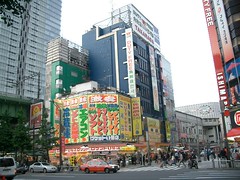 OK boys and girls (alright, maybe mainly the boys), this is what you want to see in Tokyo. Akihabara, the electrical retailing area. If you’re looking for toys this is the place to come, imagine an area the size of a large town centre in the UK that has nothing but stores selling PC’s, HiFi, games, DVD’s, and also washing machines and other white goods if you like (the fridge freezers were particularly exciting). The largest place we went in was probably about the size of your average out of town Currys or PC World..... but there were 6 floors.
OK boys and girls (alright, maybe mainly the boys), this is what you want to see in Tokyo. Akihabara, the electrical retailing area. If you’re looking for toys this is the place to come, imagine an area the size of a large town centre in the UK that has nothing but stores selling PC’s, HiFi, games, DVD’s, and also washing machines and other white goods if you like (the fridge freezers were particularly exciting). The largest place we went in was probably about the size of your average out of town Currys or PC World..... but there were 6 floors.I could have spent all week here (and I did try), but Nikky was somewhat less keen especially given the fact that the Japanese don’t seem to go in for any kind of benches or seats in public areas where she could sit and wait for me!
One oddity we did discover, well more of a question really..... The Japanese are very fashion conscious (they spend huge amounts on designer clothes and handbags etc.) and they also have one of the most advanced mobile phone networks in the world (in terms of what you can do on and with the phones). So why is it that they have, without a doubt, absolutely the ugliest collection of mobile phones ever assembled? Discuss!
Shinjuku and Roppongi
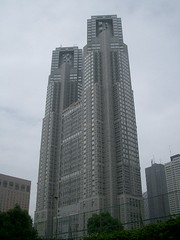 Surrounding the insanity of Shinjuku station are all sorts of banks and office buildings in addition to some of the most expensive hotels in Tokyo. It is also home to the Tokyo Metropolitan Government Offices..... which are therefore possibly the most imposing ‘council offices’ on the planet! This area was also apparantly the inspiration for the skylines and architecture in Bladerunner, although I’ve read that Osaka may have been used for filming (I’m sure someone will correct me if I'm wrong).
Surrounding the insanity of Shinjuku station are all sorts of banks and office buildings in addition to some of the most expensive hotels in Tokyo. It is also home to the Tokyo Metropolitan Government Offices..... which are therefore possibly the most imposing ‘council offices’ on the planet! This area was also apparantly the inspiration for the skylines and architecture in Bladerunner, although I’ve read that Osaka may have been used for filming (I’m sure someone will correct me if I'm wrong).There’s not a lot to say about the area known as Roppongi Hills, other than that it just seems like one great big shopping and restaurant complex attached to a huge office tower, another luxury hotel and some very high rent residential property. If you want to do all your designer shopping in one place this may be a good place to start..... as long as you’re a girl. We didn’t really visit the shops, but a glance at the guidebook (it has one) shows hardly any mens clothing stores, and at least 11 shops specialising in handbags! When you’re done with shopping then there seem to be at least 40 cafes and restaurants to choose from, and a cinema that opens until 3 or 4am at the weekends.
Sunday, May 14, 2006
Ueno
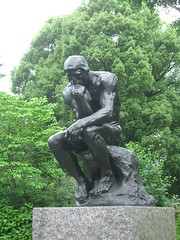 Ueno is one of the two main stations in the city, but it also right next door to a large park area. There are of course more shrines around the park, but should you be stuck here in apalling weather it’s probably a good place to come as some of the biggest of Tokyo’s many museums are here. We didn’t have time to do the museums, so we only got to see the Rodin statues outside the museum of Western art (cast from the artists original moulds apparently).
Ueno is one of the two main stations in the city, but it also right next door to a large park area. There are of course more shrines around the park, but should you be stuck here in apalling weather it’s probably a good place to come as some of the biggest of Tokyo’s many museums are here. We didn’t have time to do the museums, so we only got to see the Rodin statues outside the museum of Western art (cast from the artists original moulds apparently).Saturday, May 13, 2006
Big Scary City?
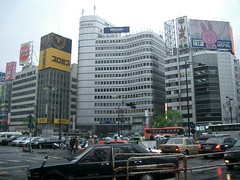 Pick any guide book and you’ll find scary statistics about Tokyo. The ‘city’ has a population of something like 12 million, but more than thirty million live within 20 miles of the Imperial Palace. Shinjuku station is said to be the busiest in the world and is used by nearly 3 million people a day. Well we’ve only been here a week, but based on our limited experience it really isn’t scary. Shinjuku is a very busy station, but it looks like it was designed to cope (have these guidebook writers never been to Paddington in the evening?!).
Pick any guide book and you’ll find scary statistics about Tokyo. The ‘city’ has a population of something like 12 million, but more than thirty million live within 20 miles of the Imperial Palace. Shinjuku station is said to be the busiest in the world and is used by nearly 3 million people a day. Well we’ve only been here a week, but based on our limited experience it really isn’t scary. Shinjuku is a very busy station, but it looks like it was designed to cope (have these guidebook writers never been to Paddington in the evening?!).My one tip for anyone visiting on holiday would be to not worry too much about where your hotel is. If you look at a map of Tokyo it’s quite difficult to work out where the ‘centre’ is. The sights and shopping areas seem to be spread over a far greater area than in, say, London but the public transport is very efficient so getting around is pretty easy. It also means that even though we were here for almost a week we still didn’t see everything.....
Friday, May 12, 2006
A Bed In Tokyo
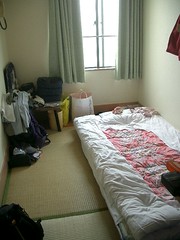 Our super cheap hotel turned out to be very entertaining with something of a hostel atmosphere. Our fellow guests were quite a mixed bunch, other budget travellers as well as Japanese and foreigners who were in Tokyo on business. Then there was the woman who claimed to be in town to work, but seemed to spend most days in the lobby on the internet. Most fun of all was the apparently crazy (and frequently drunk) Japanese man, who didn’t let his limited English get in the way of his attempts to engage anyone who would listen in conversation. We never learned a great deal about him, but we do know that his home town was in a ‘Ski area’ (as this was one of his best bits of English).
Our super cheap hotel turned out to be very entertaining with something of a hostel atmosphere. Our fellow guests were quite a mixed bunch, other budget travellers as well as Japanese and foreigners who were in Tokyo on business. Then there was the woman who claimed to be in town to work, but seemed to spend most days in the lobby on the internet. Most fun of all was the apparently crazy (and frequently drunk) Japanese man, who didn’t let his limited English get in the way of his attempts to engage anyone who would listen in conversation. We never learned a great deal about him, but we do know that his home town was in a ‘Ski area’ (as this was one of his best bits of English).Most of the rooms are singles, which we have discovered is quite common in Japan and leads to quite good pricing if you should be travelling here on your own. So we had two adjacent single rooms, which meant we also had two TV’s and two fridges (so we could have had a beer fridge if they had both worked!). It may not look much in the picture, but the rooms were clean and the hotel had everything we needed.
It was here that we first discovered the many joys(?) of some more ‘traditional’ Japanese hotels. In your room you are provided a dressing gown and a pair of slippers, very nice you think. However, what may surprise you is that it seems quite acceptable to just wander around the hotel wearing nothing but these items. So in the hotel lobby, which was basically the common area with TV, computers, vending machines and seating areas there would be several guests (at almost any time of day) just checking their email in their gown and slippers!
Our next fun discovery was the bathing arrangements. There are a few shared bathrooms in the building that have normal showers, but on the top floor is also a traditional communal Japanese bath. Ladies have their own time slot, very generously they are allowed exclusive use between 10pm and midnight, other than that it’s men only!!
You also need to pay attention to the rules. You have to wash first, before getting into the bath. There’s a communal shower area where you sit on a small stool (OK it looks more like a potty than a stool) and wash. Obviously you want to be seen to be very thorough, you wouldn’t want the other bathers to think you were unclean. Then, once you’ve done all that you can finally get into the bath, remembering the number one rule. Under NO circumstances must any trace of soap enter the bath. The bath if for soaking and relaxing, not washing. So then you just sit there, up to your neck in what feels like near boiling water, ‘relaxing’. I know it all sounds a bit odd, and it did take me several days to build myself up for it, but it’s quite fun really once you know the rules... Honestly!
Back Across The Equator
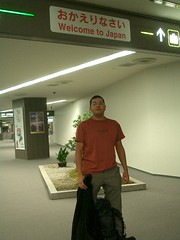 After an 11 hour daytime flight we were at least arriving without any jetlag, as Tokyo is only three hours behind Auckland. We could have stayed on the plane longer, mainly because I hadn’t had time to watch all the movies I wanted to(!) but also because we were a little unsure how we were going to cope with the language barrier. The excessively jovial (and not as funny as he thought) Englishman in front of us at immigration failed to cause a ‘diplomatic incident’, so the rest of us were let through without too much delay. We may have been lucky, as the queuing system at Narita airport looks a bit like Disneyland, complete with signposts at various points along the queue saying things like “60 Minutes wait from here”!!!
After an 11 hour daytime flight we were at least arriving without any jetlag, as Tokyo is only three hours behind Auckland. We could have stayed on the plane longer, mainly because I hadn’t had time to watch all the movies I wanted to(!) but also because we were a little unsure how we were going to cope with the language barrier. The excessively jovial (and not as funny as he thought) Englishman in front of us at immigration failed to cause a ‘diplomatic incident’, so the rest of us were let through without too much delay. We may have been lucky, as the queuing system at Narita airport looks a bit like Disneyland, complete with signposts at various points along the queue saying things like “60 Minutes wait from here”!!!The next thing to do was to find our way to the super-cheap (how DO we find these places?!) hotel we had booked. I had read a few things about bag delivery services that will deliver your bags to any hotel by the following morning. We’d normally be perfectly happy to carry our own bags (and too tight to pay someone else to do it), but it sounded quite appealing given the alternative of carrying two fully loaded backpacks through the Tokyo public transport system on a busy Friday evening.
So delivery service it was, and my first proper experience with the language barrier. Thinking that I could blag one of these delivery services for free by simply showing the correct shiny credit card I set off in search of the right desk. At the end of my search I found myself on the top floor at a very quiet end of the terminal. The lady at the counter was very friendly but spoke less English than I do Japanese. However, she obviously had some experience of handling crazy tourists and quickly turned to her PC and pulled up a language translation website. It turned out that this was one of my less successful pieces of internet research, as after seeing my card she confidently typed some characters and then turned the monitor for me to read the translation, which said (roughly) “you’ve got no chance mate”.
So it was back downstairs for Plan B, paying with real cash! All was going well until it became obvious that the guy filling out the delivery form couldn’t really figure out where the hotel was (we had the address written in Roman characters, but not Japanese). So he phoned the hotel and had a remarkably long conversation during which he took lengthy notes..... After all this we still weren’t entirely convinced that we were going to see our bags again, but he seemed happy and gave us a receipt showing a delivery time of between 10am and 12. So we waved them goodbye and headed for the train planning how we’d spend the insurance money.......
The train journey was fairly uneventful and straightforward. The Tokyo metro signage was apparently overhauled for the last World Cup, so all the stations are not only labelled in Japanese and English but they also have a simple coding system based on the name of the line and the station number (Eg. Mitsukoshimae on the Ginza Line is much easier to find when you know it’s G12).
After all that the hotel turned out to be very nice, not too far from train and we can assure you that £15 each per night is a bargain in this city.
..... oh, and the bags turned up the next morning. Early!
Konnichiwa!
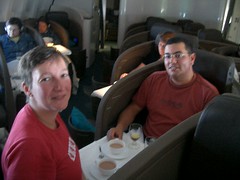 After an 11 hour daytime flight we were at least arriving without any jetlag, as Tokyo is only three hours behind Auckland. We could have stayed on the plane longer, mainly because I hadn’t had time to watch all the movies I'd chosen(!) but also because we were a little unsure how we were going to cope with the language barrier. The excessively jovial (and not as funny as he thought) Englishman in front of us at immigration failed to cause a ‘diplomatic incident’, so the rest of us were let through without too much delay. We may have been lucky, as the queuing system at Narita airport looks a bit like Disneyland, complete with signposts at various points along the queue saying things like “60 Minutes wait from here”!!!
After an 11 hour daytime flight we were at least arriving without any jetlag, as Tokyo is only three hours behind Auckland. We could have stayed on the plane longer, mainly because I hadn’t had time to watch all the movies I'd chosen(!) but also because we were a little unsure how we were going to cope with the language barrier. The excessively jovial (and not as funny as he thought) Englishman in front of us at immigration failed to cause a ‘diplomatic incident’, so the rest of us were let through without too much delay. We may have been lucky, as the queuing system at Narita airport looks a bit like Disneyland, complete with signposts at various points along the queue saying things like “60 Minutes wait from here”!!!The next thing to do was to find our way to the super-cheap (how DO we find these places?!) hotel we had booked. I had read a few things about bag delivery services that will deliver your bags to any hotel by the following morning. We’d normally be perfectly happy to carry our own bags (and too tight to pay someone else to do it), but it sounded quite appealing given the alternative of carrying two fully loaded backpacks through the Tokyo public transport system on a busy Friday evening.
So delivery service it was, and my first proper experience with the language barrier. Thinking that I could blag one of these delivery services for free by simply showing the correct shiny credit card I set off in search of the right desk. At the end of my search I found myself on the top floor at a very quiet end of the terminal. The lady at the counter was very friendly but spoke less English than I do Japanese. However, she obviously had some experience of handling crazy tourists and quickly turned to her PC and pulled up a language translation website. It turned out that this was one of my less successful pieces of internet research, as after seeing my card she confidently typed some characters and then turned the monitor for me to read the translation, which said (roughly) “you’ve got no chance mate”.
So it was back downstairs for Plan B, paying with real cash! All was going well until it became obvious that the guy filling out the delivery form couldn’t really figure out where the hotel was (we had the address written in Roman characters, but not Japanese). So he phoned the hotel and had a remarkably long conversation during which he took copious notes..... After all this we still weren’t entirely convinced that we were going to see our bags again, but he seemed happy and gave us a receipt showing a delivery time of between 10am and 12. So we waved them goodbye and headed for the train planning how we’d spend the insurance money.......
The train journey was fairly uneventful and straightforward. The Tokyo metro signage was apparently overhauled for the last World Cup, so all the stations are not only labelled in Japanese and English but they also have a simple coding system based on the name of the line and the station number (Eg. Mitsukoshimae on the Ginza Line is much easier to find when you know it’s also 'G12').
After all that the hotel turned out to be very nice, close to the station, in front of a bus stop, and (at £15 each per night) is an absolute bargain in this city.
...... oh, and the bags turned up the next morning. Early!
